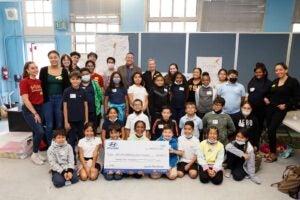
Drones, Drones Drones!
Squeals of excitement filled the air along with 15 drones during an after-school workshop attended by 24 fourth- and fifth-grade students from Ms. Brown and Ms. Tigolo’s classes at Foshay Learning Center this fall. The goal of this workshop was to teach the science and technology of drones by having the students learn about the parts that make up the average drone, and how to maneuver a drone. The students even had the opportunity to fly a drone (or two). The workshop had three main stations: the DIY drones that students could take home, the drone imaging station, and a drone flying station which also had an obstacle course. The activities were created by Keshav Subramanian and DJ Kast. Ms. Vanessa Brown, fourth grade teacher, had this to say about the drone workshop: “Amazing program. [It was] interactive on so many levels of drone education. My students were engaged and so excited”.
Station 1: Drone Hand Propellers
Juan Zarate-Diaz, T’ayra Cannon, and Amanda Castillo create their flying propellers. Photo by DJ Kast
At this station, students learned about propellers, which give drones the ability to fly by creating a difference in air pressure between the top and bottom surface of the propeller. Students created their own propellers out of tongue depressors and chopsticks. Once they created their propellers, they flew them outside! We also had a plastic alternative that looked like a flying saucer that students launched into the air (some so high that they landed on the Foshay roof!).
Station 2: Drone Imaging
TA’s Ishika Agrawal and Ali Elmashat work together to run the wildfire drone imagine station. The camera feed in the drone that Ali (bottom left corner) is holding is relayed to the phone in Ishika’s hand in the top middle of the photo. Photo by DJ Kast
Drones have the ability to capture and transmit amazing aerial images, allowing for new and unique perspectives of the world. JEP STEM staff–including Ali Elmashat, Mia Smith, Eduardo Lopez, and Ipek Narbay–held up a drone with a camera above four dioramas that represented various settings in which a drone could be used. Foshay students drew the corresponding images that showed up on the image that was being relayed to their phones. Students drew images of a forest with a lost hiker, Los Angeles traffic during rush hour, a wildfire, and a safari, showcasing the wide range of applications of drone imaging.
Station 3: Drone Flying
Fifth grader, Christian Velasco controls the tiny blue drone’s flight pattern with his hands. Photo by DJ Kast
Students flew two main types of drone: a hand operated one and a remote control drone. They had to complete a small obstacle course consisting of a hula hoop, a turning post and a landing pad. By flying the drone around, they gathered a better understanding of how drones maneuver. One student said “my favorite part of the workshop is that we got to fly the blue drone…I like that it didn’t need a controller, which was very interesting to me!”